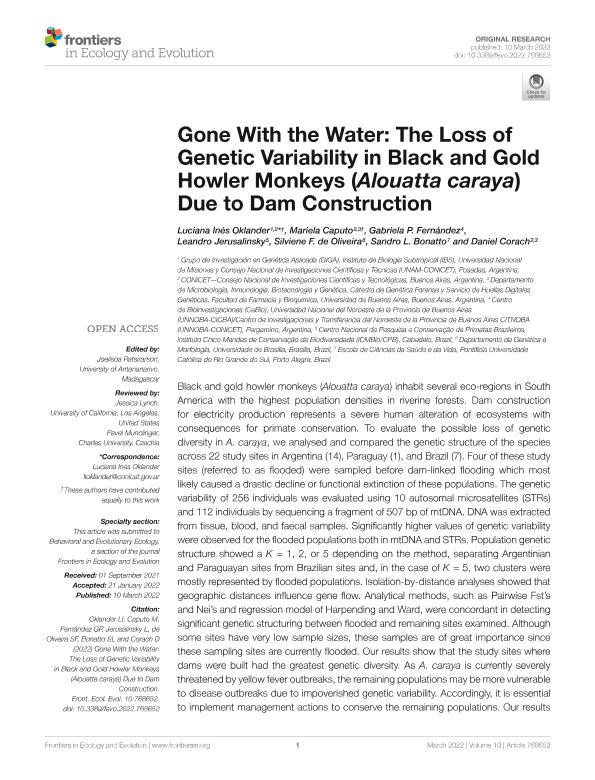Mostrar el registro sencillo del ítem
dc.contributor.author
Oklander, Luciana Inés

dc.contributor.author
Caputo, Mariela

dc.contributor.author
Fernández, Gabriela Paula

dc.contributor.author
Jerusalinsky, Leandro
dc.contributor.author
de Oliveira, Silviene F.
dc.contributor.author
Bonatto, Sandro Luis

dc.contributor.author
Corach, Daniel

dc.date.available
2023-09-26T13:06:12Z
dc.date.issued
2022-03
dc.identifier.citation
Oklander, Luciana Inés; Caputo, Mariela; Fernández, Gabriela Paula; Jerusalinsky, Leandro; de Oliveira, Silviene F.; et al.; Gone With the Water: The Loss of Genetic Variability in Black and Gold Howler Monkeys (Alouatta caraya) Due to Dam Construction; Frontiers Media; Frontiers in Ecology and Evolution; 10; 768652; 3-2022; 1-17
dc.identifier.uri
http://hdl.handle.net/11336/213038
dc.description.abstract
Black and gold howler monkeys (Alouatta caraya) inhabit several eco-regions in South America with the highest population densities in riverine forests. Dam construction for electricity production represents a severe human alteration of ecosystems with consequences for primate conservation. To evaluate the possible loss of genetic diversity in A. caraya, we analysed and compared the genetic structure of the species across 22 study sites in Argentina (14), Paraguay (1), and Brazil (7). Four of these study sites (referred to as flooded) were sampled before dam-linked flooding which most likely caused a drastic decline or functional extinction of these populations. The genetic variability of 256 individuals was evaluated using 10 autosomal microsatellites (STRs) and 112 individuals by sequencing a fragment of 507 bp of mtDNA. DNA was extracted from tissue, blood, and faecal samples. Significantly higher values of genetic variability were observed for the flooded populations both in mtDNA and STRs. Population genetic structure showed a K = 1, 2, or 5 depending on the method, separating Argentinian and Paraguayan sites from Brazilian sites and, in the case of K = 5, two clusters were mostly represented by flooded populations. Isolation-by-distance analyses showed that geographic distances influence gene flow. Analytical methods, such as Pairwise Fst’s and Nei’s and regression model of Harpending and Ward, were concordant in detecting significant genetic structuring between flooded and remaining sites examined. Although some sites have very low sample sizes, these samples are of great importance since these sampling sites are currently flooded. Our results show that the study sites where dams were built had the greatest genetic diversity. As A. caraya is currently severely threatened by yellow fever outbreaks, the remaining populations may be more vulnerable to disease outbreaks due to impoverished genetic variability. Accordingly, it is essential to implement management actions to conserve the remaining populations. Our results underline the importance for Environmental Impact Assessments (EIA) to include data on the genetic structure of species in the affected sites prior to their alteration or destruction. These genetic data are also remarkably important for determining where to relocate specific individuals to help avoid biodiversity loss.
dc.format
application/pdf
dc.language.iso
eng
dc.publisher
Frontiers Media

dc.rights
info:eu-repo/semantics/openAccess
dc.rights.uri
https://creativecommons.org/licenses/by/2.5/ar/
dc.subject
ALOUATTA CARAYA
dc.subject
CONSERVATION
dc.subject
DAM CONSTRUCTION
dc.subject
GENETIC STRUCTURE
dc.subject
HOWLER MONKEYS
dc.subject.classification
Conservación de la Biodiversidad

dc.subject.classification
Ciencias Biológicas

dc.subject.classification
CIENCIAS NATURALES Y EXACTAS

dc.title
Gone With the Water: The Loss of Genetic Variability in Black and Gold Howler Monkeys (Alouatta caraya) Due to Dam Construction
dc.type
info:eu-repo/semantics/article
dc.type
info:ar-repo/semantics/artículo
dc.type
info:eu-repo/semantics/publishedVersion
dc.date.updated
2023-07-07T21:51:07Z
dc.identifier.eissn
2296-701X
dc.journal.volume
10
dc.journal.number
768652
dc.journal.pagination
1-17
dc.journal.pais
Suiza

dc.journal.ciudad
Lausana
dc.description.fil
Fil: Oklander, Luciana Inés. Consejo Nacional de Investigaciones Científicas y Técnicas. Centro Científico Tecnológico Conicet - Nordeste. Instituto de Biología Subtropical. Instituto de Biología Subtropical - Nodo Posadas | Universidad Nacional de Misiones. Instituto de Biología Subtropical. Instituto de Biología Subtropical - Nodo Posadas; Argentina
dc.description.fil
Fil: Caputo, Mariela. Universidad de Buenos Aires. Facultad de Farmacia y Bioquímica. Departamento de Microbiología, Inmunología y Biotecnología. Cátedra de Genética y Biología Molecular; Argentina. Consejo Nacional de Investigaciones Científicas y Técnicas. Oficina de Coordinación Administrativa Houssay; Argentina
dc.description.fil
Fil: Fernández, Gabriela Paula. Universidad Nacional del Noroeste de la Provincia de Buenos Aires. Centro de Bioinvestigaciones (Sede Pergamino); Argentina. Consejo Nacional de Investigaciones Científicas y Técnicas. Centro de Investigaciones y Transferencia del Noroeste de la Provincia de Buenos Aires. Universidad Nacional del Noroeste de la Provincia de Buenos Aires. Centro de Investigaciones y Transferencia del Noroeste de la Provincia de Buenos Aires; Argentina
dc.description.fil
Fil: Jerusalinsky, Leandro. Centro Nacional de Pesquisa e Conservação de Primatas Brazileiros; Brasil
dc.description.fil
Fil: de Oliveira, Silviene F.. Universidade do Brasília; Brasil
dc.description.fil
Fil: Bonatto, Sandro Luis. Pontificia Universidade Católica do Rio Grande do Sul; Brasil
dc.description.fil
Fil: Corach, Daniel. Consejo Nacional de Investigaciones Científicas y Técnicas. Oficina de Coordinación Administrativa Houssay; Argentina. Universidad de Buenos Aires. Facultad de Farmacia y Bioquímica. Departamento de Microbiología, Inmunología y Biotecnología. Cátedra de Genética y Biología Molecular; Argentina
dc.journal.title
Frontiers in Ecology and Evolution
dc.relation.alternativeid
info:eu-repo/semantics/altIdentifier/url/https://www.frontiersin.org/articles/10.3389/fevo.2022.768652/full
dc.relation.alternativeid
info:eu-repo/semantics/altIdentifier/doi/http://dx.doi.org/10.3389/fevo.2022.768652
Archivos asociados
